
Second Presbyterian Church is a landmark Gothic Revival church located on South Michigan Avenue in Chicago, Illinois, United States. In the late nineteenth and early twentieth centuries, some of Chicago's most prominent families attended this church. It is renowned for its interior, completely redone in the Arts and Crafts style after a disastrous fire in 1900. The sanctuary is one of America's best examples of an unaltered Arts and Crafts church interior, fully embodying that movement's principles of simplicity, hand craftsmanship, and unity of design. It also boasts nine imposing Tiffany windows. The church was listed on the National Register of Historic Places in 1974 and later designated a Chicago Landmark on September 28, 1977. It was designated a National Historic Landmark in March 2013.

The Second Church in Newton, United Church of Christ, is located at 60 Highland Street in West Newton, a village of Newton, Massachusetts. This church is rooted in the Congregational denomination, welcomes all visitors, and does not require uniformity of belief. Its present church building, a Gothic Victorian structure designed by architects Allen & Collens and completed in 1916, was listed in the National Register of Historic Places in 1990.
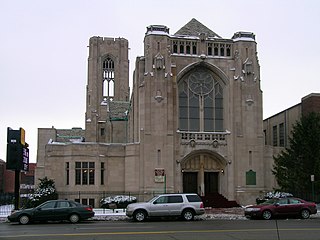
The Central Woodward Christian Church, now known as Historic Little Rock Missionary Baptist Church, is a Gothic Revival church located in Detroit, Michigan. It was listed on the National Register of Historic Places in 1993.

The Woodward Avenue Presbyterian Church is a church located at 8501 Woodward Avenue in Detroit, Michigan. Built in 1911 in the Gothic Revival style, the architect was Sidney Badgley. It was used for some time as the Abyssinia Church of God in Christ. The building was listed on the National Register of Historic Places in 1982.

The Park United Presbyterian Church is located at 14 Cortland Street in Highland Park, Michigan. It was built in 1910 as the Highland Park Presbyterian Church, listed on the National Register of Historic Places in 1982, and designated a Michigan State Historic Site in 1983. It is a member of The Presbyterian Church (U.S.A.), and continues to offer services.

The former First Unitarian Church is a historic church building at 130 Highland Avenue in Somerville, Massachusetts. The stone church was built in 1894 for a Unitarian congregation. It was designed by Hartwell & Richardson and is a good example of Richardsonian Romanesque design. The building presently (2022) houses the Mission Church of Our Lord Jesus Christ.

Trinity Episcopal Church is located at 1519 Martin Luther King Boulevard in the Woodbridge Historic District of Detroit, Michigan. The church was designated a Michigan State Historic Site in 1979 and listed on the National Register of Historic Places in 1980. It is now known as Spirit of Hope.
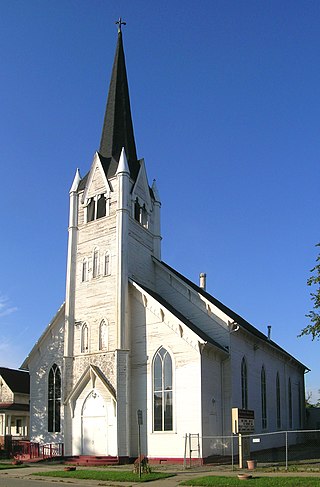
The Gethsemane Evangelical Lutheran Church is a church located at 4461 Twenty-Eighth Street in Detroit, Michigan. It was designated a Michigan State Historic Site in 1980 and listed on the National Register of Historic Places in 1982. The building now houses the Motor City Missionary Baptist Church.

The First Presbyterian Church in Batavia, New York, United States, is located at East Main and Liberty streets. It is a joined complex of several buildings. The main one, the church's sanctuary, is a limestone Gothic Revival structure built in the mid-19th century. Its congregation was the first church to be organized in Batavia, albeit as a Congregationalist group at that time.

The First Congregational Church, United Church of Christ, also known as the New Old South Congregational Church, is a historic church at 235 Main Street in Farmington, Maine. The congregation's present sanctuary is a brick Romanesque structure designed by George M. Coombs and was completed in 1887. It is the town's finest 19th-century church, and one of the most architecturally sophisticated in the region. It was listed on the National Register of Historic Places in 1974. The congregation, established in 1814, celebrated its 200th anniversary in 2014.

The First Baptist Church of Ossining is located in the center of the village of Ossining, New York, United States. It is a brick building in the Gothic Revival architectural style with a tall wooden steeple built in the 1870s, one of Ossining's most prominent landmarks. In 1973 it was listed on the National Register of Historic Places. Sixteen years later, in 1989, it was included as a contributing property to the Downtown Ossining Historic District when it was listed on the Register.

The Christ Church Chapel is a religious building located at 61 Grosse Pointe Blvd. in Grosse Pointe Farms, Michigan. It is also known as the Christ Church Grosse Pointe or the Christ Episcopal Church. It was designated a Michigan State Historic Site in 1992 and listed on the National Register of Historic Places in 1993.

The First Congregational Church of Manistee, Michigan is a church located at 412 South 4th Street in Manistee, Michigan. It was listed on the National Register of Historic Places in 1974.

First Congregational Church is a congregation of the United Church of Christ located in Eldora, Iowa, United States. The congregation was organized in 1868 and the church building was individually listed on the National Register of Historic Places in 1996. In 2010 it was included as a contributing property in the Eldora Downtown Historic District in 2010.
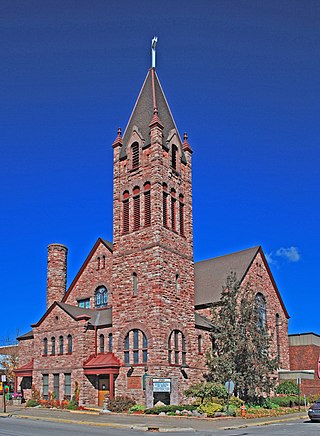
Central Methodist Episcopal Church is a United States historic church at 111 E. Spruce Street in Sault Ste. Marie, Michigan. It was listed on the National Register of Historic Places in 1984 and designated a Michigan State Historic Site in 1993.
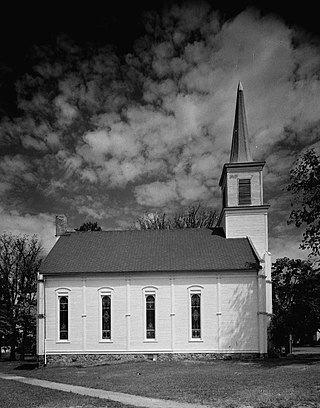
The First Congregational Church is a historic church located at 110 S. Main Street in Vermontville, Michigan. It was built in 1862 and added to the National Register of Historic Places in 1971, and is part of the Historic American Buildings Survey.

The Sewall Memorial Congregational Church is a historic church at 558 United States Route 1 in Robbinston, Maine. Built in 1911, it is the small community's only example of a Late Victorian church, with an asymmetrical Queen Anne style. The church, whose congregation dates to the early 19th century, was listed on the National Register of Historic Places in 2012. It is affiliated with the United Church of Christ.
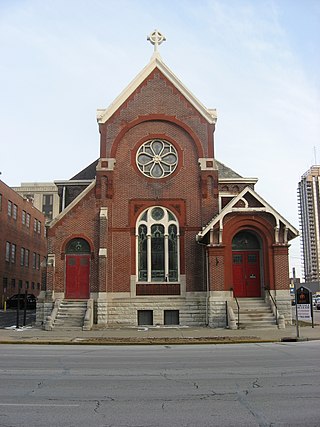
Mount Pisgah Lutheran Church, also known in its early years as the First Lutheran Church and First English Lutheran Church and more recently as The Sanctuary on Penn, is located at 701 North Pennsylvania Street in downtown Indianapolis, Indiana. The historic church was built by the city's first Lutheran congregation, which organized in 1837, and was its third house of worship. The former church, whose present-day name is The Sanctuary on Penn, is operated as a for-profit event venue.
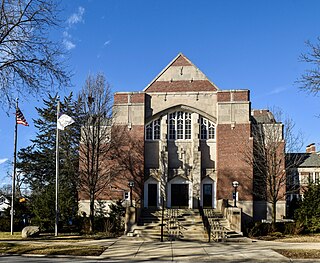
First Congregational Church is a historic Congregational church at 766 Graceland Avenue in Des Plaines, Illinois. The church's congregation formed in 1869 and built its first church in the early 1870s. As Des Plaines expanded in the 1920s, the congregation outgrew its original church, and it had the current church building constructed in 1929. The firm of Pond & Pond, Martin and Lloyd gave the church an Arts and Crafts design; it is one of the few buildings in Des Plaines designed by a major architecture firm. The church's design includes a brick and limestone exterior with an emphasis on geometric patterns, a gable front entrance flanked by square towers, and an arched window divided by buttresses above the entrance. Its sanctuary houses a stained glass window designed by Edgar Miller which depicts events in the life of Christ.

The Shrine of the Black Madonna of the Pan African Orthodox Christian Church, or more simply the Shrine of the Black Madonna, is a church building located at 7625 Linwood Street in Detroit, Michigan. It is significant for its association with civil rights leader Rev. Albert B. Cleage Jr., and as the location of many significant 20th century African American civil rights activities. The building was listed on the National Register of Historic Places in 2021.
























